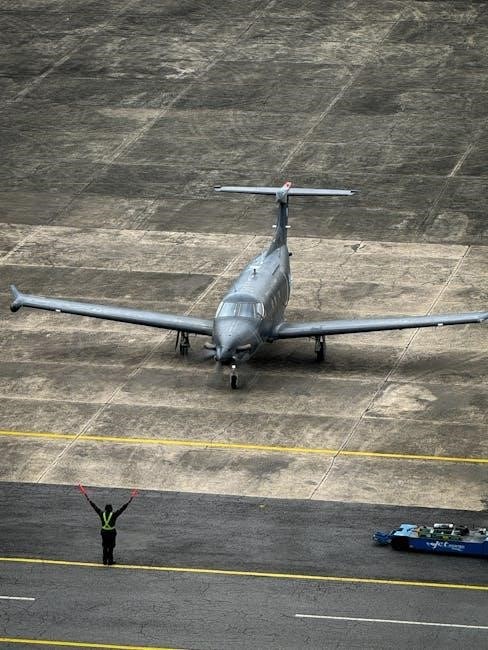The Multi-Engine Oral Exam Guide is a comprehensive resource designed to help pilots prepare for the FAA oral and practical exams. It covers essential topics such as aircraft systems, performance specifications, and emergency procedures, providing a detailed preview of the checkride. This guide is ideal for both Part 61 and Part 141 training programs, ensuring applicants are well-prepared for the multi-engine rating.
1.1 Overview of the Guide
The Multi-Engine Oral Exam Guide is a structured resource that outlines the key areas of knowledge required for the FAA multi-engine oral exam. Divided into sections, it covers aircraft systems, performance, and operational procedures. The guide includes practical exam preparation tips and focuses on critical topics such as weight and balance, emergency protocols, and aircraft limitations. Designed for pilots pursuing multi-engine ratings, it serves as a roadmap to mastering the concepts and scenarios typically encountered during the checkride process.
1.2 Importance of the Oral Exam in Multi-Engine Training
The Multi-Engine Oral Exam is a critical component of multi-engine training, ensuring pilots demonstrate a deep understanding of aircraft systems, safety protocols, and operational procedures. It assesses the ability to think critically and make sound decisions under pressure. The exam focuses on key areas such as engine management, emergency procedures, and performance limitations, preparing pilots for real-world scenarios. Passing the oral exam is essential for obtaining the multi-engine rating, as it validates a pilot’s readiness to safely operate complex aircraft in various conditions.
1.3 Structure of the Guide
The Multi-Engine Oral Exam Guide is organized into clear sections, each focusing on specific knowledge areas. It begins with an introduction, followed by detailed chapters on aircraft systems, regulations, and emergency procedures. The guide uses a question-and-answer format, mimicking real exam scenarios, and includes practical examples to reinforce learning. This structured approach ensures comprehensive preparation, covering all aspects of multi-engine operations. By following the guide, pilots can systematically build their knowledge and confidence, ensuring readiness for the FAA oral exam and practical checkride.

Understanding Multi-Engine Aircraft Basics
Multi-engine aircraft differ from single-engine planes due to redundancies in systems like engines, fuel, and electrical components. Understanding these systems is crucial for safe operations and optimal performance.
2.1 Differences Between Single and Multi-Engine Aircraft
Multi-engine aircraft offer redundancy, enhancing safety, while single-engine planes rely on one power source. Multi-engine planes have more complex systems, including fuel distribution and propeller controls, requiring additional training. They also provide better performance in certain conditions but are heavier and more expensive to maintain. Understanding these differences is vital for pilots to operate multi-engine aircraft safely and effectively, ensuring they can handle emergencies and optimize flight performance.
2.2 Key Characteristics of Multi-Engine Aircraft
Multi-engine aircraft are characterized by their redundancy in power systems, offering improved safety and performance. These aircraft feature multiple engines, propeller feathering capabilities, and complex fuel distribution systems. They are typically heavier and require more maintenance compared to single-engine planes. Key traits include the ability to feather propellers, manage fuel flow across engines, and maintain control during single-engine operations. Understanding these characteristics is crucial for pilots to optimize performance, handle emergencies, and ensure safe flight operations under various conditions.
2.3 Critical Engine Concept
The critical engine concept is a fundamental aspect of multi-engine aircraft operation, particularly during takeoff and single-engine scenarios. It refers to the engine whose failure would result in the highest drag or most adverse yaw, typically the left engine due to propeller rotation. Pilots must understand this concept to determine the minimum controllable airspeed (Vmc) and safely operate the aircraft. The critical engine’s identification is crucial for maintaining control and achieving optimal performance during emergencies, ensuring safe flight operations under various conditions.

FAA Regulations and Requirements
The FAA mandates specific regulations for multi-engine aircraft, including required documents like the Airworthiness Certificate and adherence to inspection and maintenance standards outlined in 14 CFR.
3.1 Overview of FAA Regulations for Multi-Engine Ratings
The FAA establishes specific regulations for obtaining a multi-engine rating, requiring applicants to meet rigorous standards. These include completing ground and flight training, passing a written exam, and demonstrating proficiency during a practical test. Pilots must hold a valid pilot certificate and medical certificate, and the aircraft used for training must meet airworthiness requirements. Additionally, regular inspections and maintenance must comply with 14 CFR guidelines to ensure safety and regulatory adherence. Understanding these regulations is crucial for successful certification and legal operation of multi-engine aircraft.
3.2 Required Documents for Multi-Engine Aircraft
Operating a multi-engine aircraft requires specific documents to ensure legality and safety. The Airworthiness Certificate confirms the aircraft is fit for flight. A valid Registration Certificate must be onboard, along with a Pilot’s Operating Handbook (POH) for the specific aircraft. Additionally, a Weight and Balance Report and Maintenance Records must be current and accessible. These documents are essential for compliance with FAA regulations and for demonstrating adherence to safety standards during inspections or exams.
3.3 Inspection and Maintenance Requirements
Regular inspections are critical to ensure the airworthiness of multi-engine aircraft. Annual inspections, 100-hour inspections for commercial operations, and pre-flight checks are mandatory. Compliance with 14 CFR 91.409 and 91.413 is essential. Maintenance records must be up-to-date, detailing all inspections and repairs. Proper documentation ensures adherence to FAA regulations and enhances safety. Pilots must review these records before flight to confirm compliance and operational readiness.

Aircraft Systems and Performance
The guide covers engine specifications, fuel systems, propeller feathering, and aircraft performance limits. It details how these systems interact and impact overall flight capabilities and safety margins.
4.1 Engine Specifications and Fuel Systems
Understanding engine specifications and fuel systems is crucial for multi-engine operations. The guide details engine power ratings, fuel injection systems, and fuel distribution. It explains how fuel flow affects performance and efficiency, emphasizing crossfeeding techniques to manage fuel imbalance during emergencies. Proper fuel management is essential for maintaining power and ensuring safe flight operations, making this section vital for exam preparation.
4.2 Propeller and Feathering Systems
Propeller systems in multi-engine aircraft are critical for performance and safety. Feathering allows the propeller to rotate into a low-drag position when an engine fails, reducing drag and maintaining control. The guide explains propeller pitch, synchronization, and auto-feather features. Understanding these systems is essential for managing engine failures and ensuring smooth operation. Proper feathering techniques are emphasized to optimize aircraft performance during emergencies, making this section a key focus for exam preparation.
4.3 Aircraft Performance and Limitations
Aircraft performance and limitations are critical for safe multi-engine operations. Understanding factors like power settings, propeller pitch, and feathering is essential for optimizing performance. Limitations include maximum takeoff weight, climb rates, and service ceilings. The guide emphasizes how weight distribution and fuel loads impact performance, especially during engine failures. Pilots must know how to manage these factors to maintain control and achieve desired flight outcomes. This section ensures a thorough understanding of the aircraft’s capabilities and constraints, preparing candidates for real-world scenarios and exam questions.

Weight and Balance Considerations
Calculating weight and balance is crucial for safe multi-engine operations. Proper loading techniques ensure safety margins and optimize performance, critical for maintaining aircraft stability during flight.
5.1 Calculating Weight and Balance for Multi-Engine Aircraft
Calculating weight and balance for multi-engine aircraft involves determining the maximum gross weight, empty weight, and payload capacity. Pilots must account for fuel, passengers, and cargo, ensuring the aircraft remains within safe operating limits. Proper loading techniques prevent exceeding weight restrictions, which could compromise safety and performance. Adhering to the aircraft’s operating handbook and using load calculators helps maintain precise weight distribution. Improper balance can lead to handling issues, emphasizing the need for accurate calculations to ensure optimal flight safety and efficiency.
5.2 Loading Techniques and Safety Margins
Proper loading techniques ensure optimal aircraft performance and safety. Pilots must distribute weight evenly, avoiding overloading, which can compromise handling and efficiency. Safety margins are critical to maintain, as they prevent exceeding weight limits and ensure the center of gravity remains within acceptable ranges. Adhering to the aircraft’s loading manual and regulations, such as those outlined in 14 CFR 91.9 and 91.203, is essential. Proper loading enhances stability and reduces risks during flight, ensuring compliance with safety standards and manufacturer guidelines.
5.3 Impact of Weight Distribution on Performance
Weight distribution significantly impacts multi-engine aircraft performance. Proper balance ensures stability and optimal fuel efficiency, while uneven loading can increase drag and reduce climb rates. Excess weight in certain areas can compromise handling, particularly during takeoff and landing. Maintaining the center of gravity within limits is crucial to avoid performance degradation and potential safety risks. Understanding these dynamics is essential for pilots to ensure efficient and safe flight operations, as outlined in the Multi-Engine Oral Exam Guide.

Emergency Procedures
The Multi-Engine Oral Exam Guide covers critical emergency procedures, including engine failure response, feathering protocols, system malfunctions, and emergency landing techniques, ensuring pilots are prepared for crises.
6.1 Engine Failure and Feathering Procedures
Engine failure in multi-engine aircraft requires immediate action. Pilots must identify the failed engine, adjust power on the operating engine, and feather the propeller to minimize drag. Feathering involves aligning the propeller blades to reduce wind resistance. Proper procedures ensure control and climb performance. The Multi-Engine Oral Exam Guide emphasizes recognizing failure symptoms, such as vibration or oil pressure loss, and executing correct checklist steps. Effective feathering and power management are critical for maintaining aircraft stability and safety during emergencies, enabling a controlled descent or continued flight to a safe landing location.
6.2 System Malfunctions and Recovery Techniques
System malfunctions in multi-engine aircraft demand prompt identification and recovery. Pilots must recognize issues like hydraulic or electrical failures and isolate affected systems. Recovery involves adhering to checklist procedures, such as alternating power sources or feathering propellers to maintain control. The Multi-Engine Oral Exam Guide highlights the importance of situational awareness and effective communication. Proper techniques ensure aircraft stability, enabling safe continuation of flight or diversion to an alternate airport. Mastery of these procedures is crucial for minimizing risks and ensuring passenger safety during emergencies.
6.3 Emergency Landing and Evacuation Procedures
Emergency landings require precise execution to ensure safety. Pilots must secure the aircraft, communicate with ATC, and prepare passengers for landing. Post touchdown, rapid evacuation is critical, with crew directing passengers to exits and emergency slides. The Multi-Engine Oral Exam Guide emphasizes proper techniques to minimize injury and damage. Knowledge of evacuation routes, fire extinguisher use, and emergency communication devices is vital. Effective coordination ensures all occupants exit safely, adhering to FAA protocols for emergency scenarios.

Instrument Approaches and Navigation
Mastering instrument approaches and navigation is crucial for multi-engine pilots. The guide covers partial panel operations, TAA procedures, and advanced navigation systems to enhance situational awareness and safety.
7.1 Types of Instrument Approaches in Multi-Engine Aircraft
In multi-engine aircraft, instrument approaches include ILS, VOR, GPS, RNAV, TACAN, and NDB approaches. Each requires precise navigation and adherence to procedures. The guide details these approaches, emphasizing their unique characteristics, advantages, and challenges. Pilots must understand how to execute each type effectively, considering factors like equipment capabilities and environmental conditions. Mastery of these approaches is critical for safe and efficient flight operations, especially in low-visibility or adverse weather conditions. The guide ensures comprehensive preparation for the FAA oral exam, covering all necessary procedures and scenarios.
7.2 Partial Panel Operations and TAA Procedures
Partial panel operations involve flying solely by reference to essential instruments when others fail. Pilots must master this skill, especially in multi-engine aircraft. TAA (Terminal Arrival Area) procedures are critical for RNAV (Area Navigation) approaches, allowing structured transitions to instrument landing systems. The guide details how to handle partial panel scenarios and execute TAAs effectively, emphasizing situational awareness and precise navigation. Understanding these procedures is vital for safe operations and success in the FAA oral exam, ensuring pilots can manage system malfunctions and navigate accurately in challenging conditions.
7.3 Navigation Systems and Their Application
Modern multi-engine aircraft rely on advanced navigation systems like RNAV, GPS, and VOR for precise flight operations. These systems enable pilots to execute instrument approaches accurately. GPS provides location data, while VOR offers directional guidance. RNAV integrates multiple data sources for enhanced navigation. Understanding these systems is critical for instrument flying, especially in challenging weather conditions. The guide explains how to apply these technologies effectively, ensuring safe and efficient flight operations. Mastery of navigation systems is essential for passing the FAA oral exam and operating multi-engine aircraft proficiently.

Multi-Engine Oral Exam Preparation
Effective preparation involves mastering common questions, understanding aircraft systems, and practicing scenarios. Utilize study guides and flashcards to build confidence and clarity in responses, ensuring readiness for the exam.
8.1 Common Questions Asked During the Oral Exam
Common questions during the oral exam focus on engine failure procedures, feathering techniques, and understanding Vmc. Applicants are also asked about weight and balance calculations, emergency landing protocols, and aircraft performance limitations. Regulatory requirements, such as required documents and pre-flight inspections, are frequently covered. Additionally, examiners often inquire about system malfunctions and recovery procedures, ensuring a deep understanding of aircraft systems and operational safety. Mastery of these topics is crucial for a successful exam outcome.
8.2 Tips for Effective Preparation
Effective preparation involves thoroughly studying the Multi-Engine Oral Exam Guide and understanding key concepts like engine failure procedures and weight calculations. Reviewing aircraft systems, performance data, and emergency protocols is essential. Practicing with flashcards and mock interviews can build confidence. Focus on mastering critical areas such as Vmc, feathering systems, and regulatory requirements. Seeking guidance from instructors and reviewing real-world scenarios can enhance readiness. Organizing study materials and staying calm during the exam are also vital for success.
8.3 Strategies for Handling Examiner Scenarios
To excel in examiner scenarios, stay calm and systematically address each question. Practice consistent responses to common queries, such as engine failure procedures or feathering systems. Use checklists to ensure thoroughness and maintain situational awareness. Be concise yet confident in your answers, demonstrating clear understanding of critical areas like Vmc and system malfunctions. Familiarize yourself with real-world scenarios from the guide to anticipate potential questions. Organize your materials and remain focused, ensuring you communicate your knowledge effectively during the oral exam.

Practical Exam and Checkride
The practical exam, or checkride, evaluates your ability to safely operate a multi-engine aircraft. It includes a pre-flight inspection, in-flight maneuvers, and emergency procedures demonstration.
9.1 What to Expect During the Practical Exam
The practical exam, or checkride, is a comprehensive evaluation of your multi-engine aircraft skills. It begins with a pre-flight inspection, where you’ll demonstrate knowledge of the aircraft’s systems and documentation. In-flight, you’ll perform various maneuvers, such as engine failure procedures, feathering, and emergency landings. The examiner will simulate scenarios to test your decision-making and situational awareness. Smoothness, control, and adherence to safety protocols are critical. Be prepared to explain your actions and decisions clearly, showcasing your mastery of multi-engine operations.
9.2 Demonstration of Proficiency in Multi-Engine Operations
During the practical exam, you must demonstrate smooth control and coordination when operating multi-engine aircraft. Tasks include feathering props, managing asymmetric thrust, and performing instrument approaches. Examiners assess your ability to handle engine failures, partial panel operations, and emergency landings. Proficiency in weight and balance calculations, fuel system management, and system malfunctions is also evaluated. You’ll need to clearly explain your actions and decisions, showcasing your understanding of multi-engine principles and safety protocols. This ensures your readiness to operate safely and effectively in real-world scenarios.
9.3 Post-Exam Procedures and Certification
Upon passing the practical exam, you’ll receive a temporary airman certificate. This is valid for up to 120 days, allowing time for the FAA to process your permanent certification. Ensure all documents are filed with the local FSDO promptly. Your permanent multi-engine rating will be added to your pilot certificate, and you’ll receive an updated plastic certificate. Keep a copy of your temporary certificate for your records and ensure it’s logged in your pilot logbook. This certification is a significant milestone, marking your proficiency in multi-engine operations. Regular flight reviews and ongoing training will maintain your qualifications.

Additional Resources and Study Materials
The Multi-Engine Oral Exam Guide is supported by various resources, including recommended study guides, online flashcard apps, and flight school training programs. These tools ensure comprehensive preparation and exam success.
10.1 Recommended Study Guides and Manuals
For effective preparation, the Multi-Engine Oral Exam Guide by Michael D. Hayes is highly recommended. It offers a detailed question-and-answer format, covering critical areas like aircraft systems, performance, and emergency procedures. Additionally, the Thrust Flight Study Guide provides supplementary materials, including flashcards and practice exercises. The BE-76 Pilot Operating Handbook is also essential for understanding specific aircraft operations. These resources ensure a thorough understanding of multi-engine concepts and exam requirements, helping applicants achieve success in their checkride.
10.2 Online Tools and Flashcard Apps
Supplement your studies with online tools like the Multi-Engine Pilot Checkride App, featuring flashcards and practice questions. Flashcard Deluxe offers customizable decks for multi-engine topics. Additionally, digital platforms provide interactive study aids, such as video tutorials and mock exams. These tools enhance retention and simulate real exam scenarios, ensuring you’re well-prepared for the oral exam. Utilize these resources alongside traditional study guides for a comprehensive learning experience.
10.3 Flight School Resources and Training Programs
Flight schools offer structured training programs tailored for multi-engine ratings, often including detailed study packets and course outlines. For example, Thrust Flight provides comprehensive materials like the BE-76 Pilots Operating Handbook and additional training resources. These programs are designed for Commercial Multi-Engine, MEI, and ATP candidates, ensuring a thorough understanding of aircraft systems and operations. Many schools also offer instructor support and structured lesson plans, helping students master the multi-engine oral exam topics efficiently.
The Multi-Engine Oral Exam Guide is an essential tool for pilots seeking to master the oral exam. It provides clear, concise answers to common questions, boosting confidence and preparedness for the FAA checkride. Continuous learning and thorough preparation are key to success in multi-engine operations.
11.1 Final Tips for Success
- Thoroughly review aircraft systems, performance, and regulations to ensure a strong foundation.
- Practice answering common oral exam questions to build confidence and clarity.
- Master emergency procedures and scenarios to demonstrate quick decision-making skills.
- Stay updated on FAA regulations and aircraft-specific guidelines.
- Review performance data to understand limitations and optimal operations.
- Conduct mock interviews with instructors to simulate real exam conditions.
11.2 The Importance of Continuous Learning
Continuous learning is vital for maintaining proficiency and staying current with aviation advancements; Pilots must regularly update their knowledge of FAA regulations, aircraft systems, and operational best practices. This ensures safety and adaptability in dynamic flying environments. Engaging in periodic training, attending workshops, and reviewing updated guidelines helps pilots stay ahead. Continuous learning fosters a culture of excellence and preparedness, essential for mastering multi-engine operations and excelling in future exams.
11.3 Final Thoughts on Mastering the Multi-Engine Oral Exam
Mastery of the multi-engine oral exam requires dedication and thorough preparation. By leveraging resources like the Multi-Engine Oral Exam Guide, pilots gain insights into critical areas such as engine systems, emergency procedures, and aircraft performance. Consistent practice, understanding of regulations, and confidence during the exam are key to success. Remember, the exam is not just a test of knowledge but also a demonstration of practical skills and decision-making abilities. Stay focused, persistent, and committed to achieving excellence in your aviation career.
